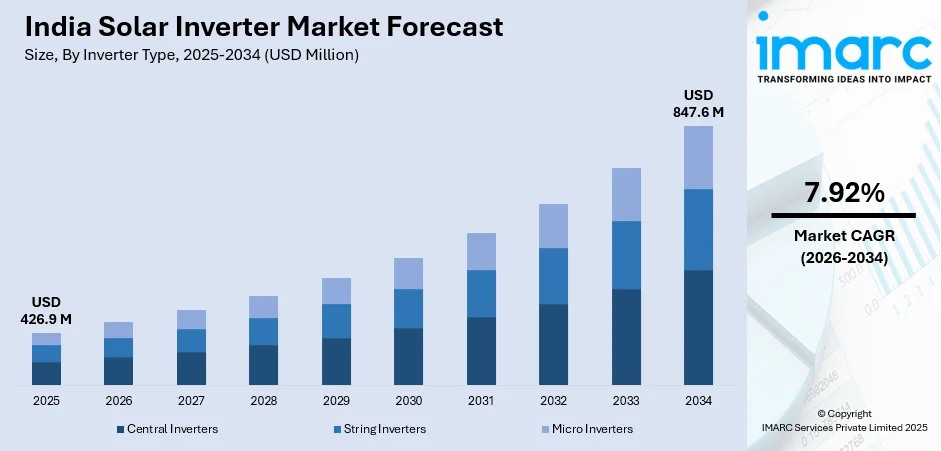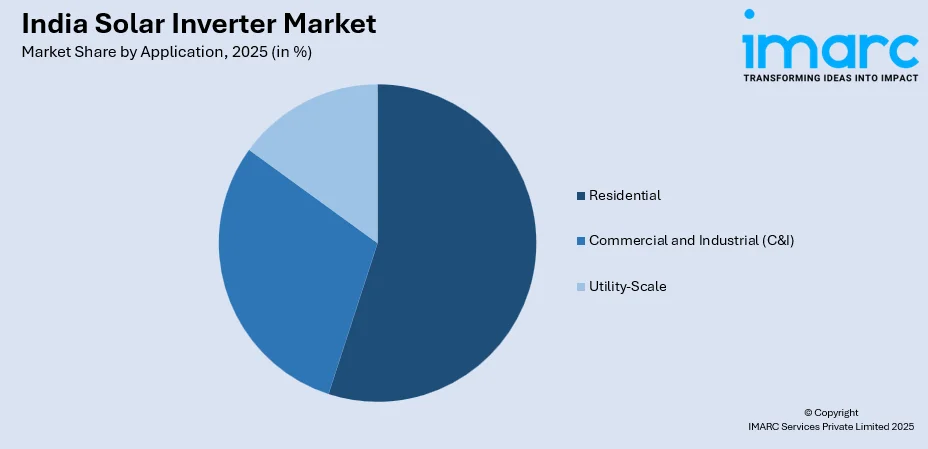
India Solar Inverter Market Size, Share, Trends and Forecast by Inverter Type, Application, and Region, 2026-2034
Market Overview:
The India solar inverter market size reached USD 426.9 Million in 2025. The market is expected to reach USD 847.6 Million by 2034, exhibiting a growth rate (CAGR) of 7.92% during 2026-2034. The growth in the market occurs since solar inverters increasingly integrate energy storage solutions, regions become more aware, and entities focus more intensely on sustainable energy solutions. Also, government incentives are supporting market development. Further, the concern that grows for environmental conservation as well as carbon footprint reduction are major factors for propelling market share.
Market Insights:
- On the basis of regional segmentation, the market has been divided into North India, West and Central India, South India, and East and Northeast India.
- On the basis of inverter type, the market has been divided into central inverters, string inverters, and micro inverters.
- On the basis of application, the market has been divided into residential, commercial and industrial (c&i), and utility-scale.
Market Size and Forecast:
- 2025 Market Size: USD 426.9 Million
- 2034 Projected Market Size: USD 847.6 Million
- CAGR (2026-2034): 7.92%
A solar inverter is a crucial component in a photovoltaic (PV) system, converting direct current (DC) electricity generated by solar panels into alternating current (AC) that can be used to power household appliances and be fed into the electrical grid. Acting as the bridge between solar panels and the electrical grid, the inverter ensures efficient energy conversion while managing the voltage and frequency of the AC output. There are various types of solar inverters, including string inverters, microinverters, and power optimizers, each with its advantages. The inverter plays a vital role in maximizing the overall performance and reliability of solar power systems by optimizing energy production and facilitating grid integration.

To get more information on this market, Request Sample
The solar inverter market in India is experiencing unprecedented growth, driven by several key factors. Firstly, the increasing regional awareness and emphasis on sustainable energy solutions have propelled the demand for solar power systems. Consequently, governments in India are implementing supportive policies and incentives to encourage the adoption of solar technology, acting as a significant catalyst for augmenting India solar inverter market share. Moreover, advancements in technology have led to more efficient and reliable solar inverters, making them an attractive choice for consumers and businesses alike. Furthermore, the declining costs of solar panels and components have made solar energy more economically viable, stimulating the demand for solar inverters. As the industry matures, economies of scale and competition have contributed to further price reductions, making solar power a cost-effective alternative. Additionally, the rising concern for environmental conservation and the need to reduce carbon footprints have prompted an accelerated shift towards renewable energy sources, with solar power at the forefront. In this context, the solar inverter market in India is witnessing an upsurge, driven by the collective efforts to embrace sustainable energy solutions and address climate change challenges. These interconnected drivers underscore the dynamic and promising trajectory of the solar inverter market in the contemporary energy landscape.
India Solar Inverter Market Trends:
Smart Grid Integration and IoT Connectivity
The sector is embracing more smart grid technology and Internet of Things (IoT) capabilities. Moreover, there are new inverters that are being equipped with advanced monitoring systems to allow for real-time data collection, remote diagnosis, and predictive maintenance. This trend allows solar system operators to optimize performance, identify issues prior to them becoming critical, and optimize energy output. Apart from this, artificial intelligence and machine learning algorithm applications in inverter systems are empowering enhanced energy generation and consumption prediction. Moreover, smart inverters also support grid stability through reactive power compensation and voltage regulation capabilities. This technology is changing the traditional inverter to make it a smart energy management system, so they are emerging as essential components in evolving next-generation smart cities and renewable energy infrastructure solutions in India. Also, this trend is significantly enhancing the India solar inverter market outlook.
Hybrid Inverter Solutions and Energy Storage Integration
The industry is witnessing a major trend towards hybrid inverter solutions that integrate solar power generation with battery energy storage systems. These new inverters are capable of handling multiple power sources in parallel, such as solar panels, grid supply, and battery power. The increasing need for energy autonomy and backup power solutions, especially in areas with unstable grid infrastructure, is fuelling this trend. Hybrid inverters maximize energy utilization by switching from various sources of power automatically depending on their availability, cost, and demand patterns. They allow homeowners and companies to store surplus solar energy at the time of peak generation and utilize it during nighttime hours or power outage periods. This trend is especially picking up pace in residential and commercial markets where energy security and cost minimization are major concern.
Growth, Opportunities, and Challenges in the India Solar Inverter Market:
- Growth Drivers: The market is experiencing strong growth, which is being fueled by government support for the adoption of renewable energy and growing installations of solar power in the country. Urbanization and growth in electricity needs are also driving the installation of solar inverters in residential, commercial, and industrial applications, hence driving the India solar inverter market growth. Advances in the efficiency of inverters and intelligent energy management systems are also fueling market growth.
- Market Opportunities: An immense opportunity lies for solar inverter producers to benefit from the increasing demand for decentralized energy solutions in rural and semi-urban areas. Increased investment in solar power initiatives and favorable policies like subsidies and net metering programs provide ideal conditions for market growth. The growing interest in hybrid and storage-integrated inverters also presents new opportunities for innovation and revenue streams.
- Market Challenges: India solar inverter market forecast indicates that high upfront installation expenses and limited access to affordable funding are still major obstacles to the mass use of solar inverters in India. The market faces challenges in two key areas: the availability of trained technicians and the poor infrastructure for after-sales maintenance and service. In addition, volatility in raw material prices and supply chain issues may impact the regular availability and affordability of products.
India Solar Inverter Market Segmentation:
IMARC Group provides an analysis of the key trends in each segment of the market, along with forecasts at the country level for 2026-2034. Our report has categorized the market based on inverter type and application.
Inverter Type Insights:
- Central Inverters
- String Inverters
- Micro Inverters
The report has provided a detailed breakup and analysis of the market based on the inverter type. This includes central inverters, string inverters, and micro inverters.
Application Insights:

- Residential
- Commercial and Industrial (C&I)
- Utility-Scale
A detailed breakup and analysis of the market based on the application have also been provided in the report. This includes residential, commercial and industrial (C&I), and utility-scale.
Regional Insights:
- North India
- West and Central India
- South India
- East and Northeast India
The report has also provided a comprehensive analysis of all the major regional markets, which include North India, West and Central India, South India, and East and Northeast India.
Competitive Landscape:
The market research report has also provided a comprehensive analysis of the competitive landscape. Competitive analysis such as market structure, key player positioning, top winning strategies, competitive dashboard, and company evaluation quadrant has been covered in the report. Also, detailed profiles of all major companies have been provided.
Latest News and Developments:
- In August 2025, Eastman Auto & Power Limited (EAPL) launched its SolarLink grid-tie inverter range, designed for residential and commercial solar applications with capacities from 3 kW to 110 kW. The inverters are built to perform efficiently even in low sunlight conditions, featuring high DC input, peak AC output, and the ability to withstand harsh climates ranging from -25 °C to +60 °C, supported by an IP65 rugged enclosure and advanced safety measures.
- In July 2025, Redington Limited entered into a partnership with Eastman Auto & Power Limited to distribute Eastman’s solar inverters, batteries, energy storage systems (ESS), and solar panels across India. This collaboration aims to support government initiatives such as Make in India and PM Surya Ghar Yojana by strengthening local manufacturing, improving access to subsidised solar solutions, and ensuring higher reliability through Eastman’s existing manufacturing and service network.
- In April 2025, Sunora Solar entered the solar inverter segment with the launch of its SUN-10HL-G4, a 15 kW three-phase grid-tied inverter, unveiled at the RenewX 2025 exhibition. The inverter supports up to 1,000 V DC input, operates over an MPPT range of 200-850 V, and is housed in a compact, weather-resistant IP66 enclosure weighing 16 kg.
- In February 2025, Hoymiles, a global leader in solar inverter technology, introduced India’s first “solar inverter brand truck” at the Intersolar India 2025 event. This initiative aims to promote awareness of solar energy and showcase advanced inverter & storage solutions across the country. The truck initiative was inaugurated by climate change advisor Shwetal Shah, with senior Hoymiles India leadership and sales teams in attendance.
India Solar Inverter Market Report Coverage:
| Report Features | Details |
|---|---|
| Base Year of the Analysis | 2025 |
| Historical Period | 2020-2025 |
| Forecast Period | 2026-2034 |
| Units | Million USD |
| Scope of the Report | Exploration of Historical Trends and Market Outlook, Industry Catalysts and Challenges, Segment-Wise Historical and Future Market Assessment:
|
| Inverter Types Covered | Central Inverters, String Inverters, Micro Inverters |
| Applications Covered | Residential, Commercial and Industrial (C&I), Utility-Scale |
| Regions Covered | North India, West and Central India, South India, East and Northeast India |
| Customization Scope | 10% Free Customization |
| Post-Sale Analyst Support | 10-12 Weeks |
| Delivery Format | PDF and Excel through Email (We can also provide the editable version of the report in PPT/Word format on special request) |
Key Benefits for Stakeholders:
- IMARC’s industry report offers a comprehensive quantitative analysis of various market segments, historical and current market trends, market forecasts, and dynamics of the India solar inverter market from 2020-2034.
- The research report provides the latest information on the market drivers, challenges, and opportunities in the India solar inverter market.
- Porter's five forces analysis assist stakeholders in assessing the impact of new entrants, competitive rivalry, supplier power, buyer power, and the threat of substitution. It helps stakeholders to analyze the level of competition within the India solar inverter industry and its attractiveness.
- Competitive landscape allows stakeholders to understand their competitive environment and provides an insight into the current positions of key players in the market.
Key Questions Answered in This Report
The solar inverter market in india was valued at USD 426.9 Million in 2025.
The India solar inverter market is projected to exhibit a CAGR of 7.92% during 2026-2034, reaching a value of USD 847.6 Million by 2034.
India solar inverter market is gaining ground through government programs like the National Solar Mission and PLI schemes, falling solar costs, higher power demand, frequent grid failures, cleaner energy awareness, advanced smart inverters, net metering, solar parks, EV charging push, and rising investments.
Need more help?
- Speak to our experienced analysts for insights on the current market scenarios.
- Include additional segments and countries to customize the report as per your requirement.
- Gain an unparalleled competitive advantage in your domain by understanding how to utilize the report and positively impacting your operations and revenue.
- For further assistance, please connect with our analysts.
 Request Customization
Request Customization
 Speak to an Analyst
Speak to an Analyst
 Request Brochure
Request Brochure
 Inquire Before Buying
Inquire Before Buying




.webp)




.webp)












